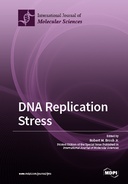Explore

This Special Issue of International Journal of Molecular Sciences (IJMS) is dedicated to the mechanisms mediated at the molecular and cellular levels in response to adverse genomic perturbations and DNA replication stress. The relevant proteins and processes play paramount roles in nucleic acid transactions to maintain genomic stability and cellular homeostasis. A total of 18 articles are presented which encompass a broad range of highly relevant topics in genome biology. These include replication fork dynamics, DNA repair processes, DNA damage signaling and cell cycle control, cancer biology, epigenetics, cellular senescence, neurodegeneration, and aging. As Guest Editor for this IJMS Special Issue, I am very pleased to offer this collection of riveting articles centered on the theme of DNA replication stress. The blend of articles builds upon a theme that DNA damage has profound consequences for genomic stability and cellular homeostasis that affect tissue function, disease, cancer, and aging at multiple levels and through unique mechanisms. I thank the authors for their excellent contributions, which provide new insight into this fascinating and highly relevant area of genome biology.
This book is included in DOAB.
Why read this book? Have your say.
You must be logged in to comment.
Rights Information
Are you the author or publisher of this work? If so, you can claim it as yours by registering as an Unglue.it rights holder.Downloads
This work has been downloaded 291 times via unglue.it ebook links.
- 40 - pdf (CC BY-NC-ND) at Unglue.it.
Keywords
- 8-chloro-adenosine
- 8-oxoG
- ?-arrestin
- A549 cells
- adaptation
- ageing
- Aging
- ALS
- Alzheimer’s disease
- AP site analogue
- APE2
- ataxia telangiectasia mutated (ATM)
- ATR
- ATR-Chk1 DDR pathway
- barley
- C9orf72
- Cancer
- cell cycle checkpoints
- Cell Death
- cellular senescence
- chromatin remodeler
- chromosome
- clock proteins
- common fragile sites
- Difficult-to-Replicate Sequences
- DNA Damage
- DNA damage response
- DNA double-strand repair
- DNA fiber assay
- DNA helicase
- DNA Repair
- DNA Replication
- DNA replication pattern
- DNA replication stress
- DNA translocation
- dormant origins
- double strand break repair
- EdU
- endonuclease IV
- Energy Metabolism
- epigenetic
- EXO1
- exonuclease 1
- Fanconi Anemia
- fork regression
- fork reversal
- G protein-coupled receptor (GPCR)
- G protein-coupled receptor kinase (GRK)
- G protein-coupled receptor kinase interacting protein 2 (GIT2)
- G2-arrest
- Gene expression
- genome instability
- Genome integrity
- genome stability
- genomic instability
- H1299 cells
- helicase
- heterogeneity
- Homologous Recombination
- Interactome
- lipofuscin
- Microsatellites
- mismatch repair
- MMR
- motor neuron disease
- Multiple Sclerosis
- mutagenicity
- Mutagens
- mutation frequency
- mutations spectra
- n/a
- NER
- neurodegeneration
- non-B DNA
- nucleolar stress
- nucleotide excision repair
- origin firing
- Oxidative Stress
- parkinson’s disease
- POL?
- Polymerase eta
- Polymerase kappa
- Post-translational modification
- premature aging
- protein stability
- R loops
- R loops, nucleolar stress
- repair of DNA damage
- replication
- replication fork restart
- replication restart
- replication stress
- replication timing
- replicative stress
- S phase
- senolytics
- SenTraGorTM (GL13)
- spacer
- SSB end resection
- SSB repair
- SSB signaling
- strand displacements
- superfamily 2 ATPase
- SupF
- template-switching
- thema EDItEUR::P Mathematics and Science::PS Biology, life sciences
- Thermococcus eurythermalis
- TLS
- TopBP1
- translesion DNA synthesis
- translesion synthesis
- Ubiquitin
- Werner Syndrome
- Werner Syndrome Protein
Links
DOI: 10.3390/books978-3-03921-390-0Editions


